| Columns Retired Columns & Blogs |
Another winner from Rogue Audio ($3,500) ......... Congratulations :-) ..........
I measured the Rogue Stereo 100 amplifier using my Audio Precision SYS2722 system (see the January 2008 "As We See It"). Before doing so, I installed the KT120 output tubes and, following the instructions in the manual, checked each tube's bias current. These were all around 50mA rather than the recommended 40mA, so, using the supplied tool, I adjusted the four trim pots. I checked the bias currents several times while performing the measurements, but none of the tubes had drifted from the recommended 40mA. The Stereo 100 has both balanced and single-ended inputs, 4 ohm and 8 ohm output-transformer taps, and its output tubes can be operated in Ultralinear or Triode mode. I took complete sets of measurements in both output modes from both sets of output taps, using the balanced inputs. I then repeated some tests using the single-ended inputs, which I understand are taken to the same input transformers as the balanced inputs.
The Stereo 100 is specified as having an input sensitivity of 1V for full power; ie, a voltage gain of 29dB. In Ultralinear mode the gain into 8 ohms from the 8 ohm tap measured 29.2dB with both the balanced and unbalanced inputs. In Triode mode from the 8 ohm tap, the gain with both inputs measured 28.8dB. As expected, the gain was lower from the 4 ohm tap, at 26.5dB Ultralinear and 26.1dB Triode. (These figures were all for the left channel; the right channel was 0.4dB less sensitive.) Both sets of inputs and output taps preserved absolute polarity (ie, were non-inverting). The input impedances varied with both frequency and input type. For the single-ended inputs I measured a high 77k ohms at 20Hz and 62k ohms at 1kHz, but 11k ohms at 20kHz. The corresponding impedances for the balanced inputs were 80k, 94k, and 16k ohms.
The output impedance varied with transformer tap and frequency, but not with output-stage mode. In both Ultralinear and Triode modes, the output impedance from the 8 ohm tap was 0.96 ohm at 20Hz, dropping to 0.48 ohm at 1kHz, and rising again to 0.85 ohm at 20kHz. As a result, the modulation of the Stereo 100's frequency response with the 8 ohm tap driving our standard simulated loudspeaker was ±0.5dB, before rapidly rolling off above 25kHz (fig.1, gray trace). Fig.1 was taken in Ultralinear mode; in Triode mode (fig.2) the ultrasonic rolloff was more extreme, the output into 8 ohms (blue and red traces) being down by 2dB at 20kHz, and was even further depressed into 2 ohms (green). This increased the risetimes with a 10kHz squarewave (fig.3), though Ultralinear mode gave a squarer waveform, with just the slightest hint of ringing on the tops and bottoms (fig.4). The 1kHz squarewave was superbly square in both modes (fig.5), a tribute to the Stereo 100's output transformers.
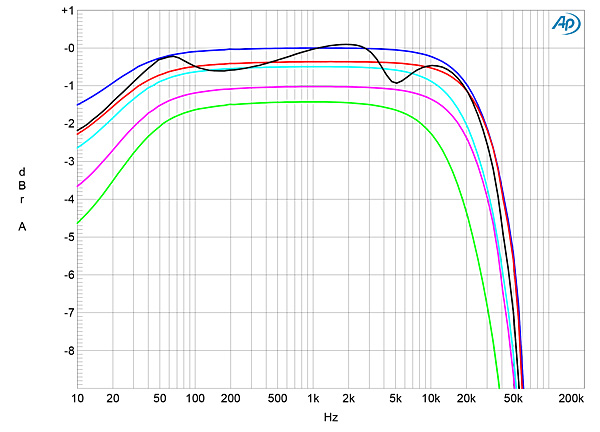
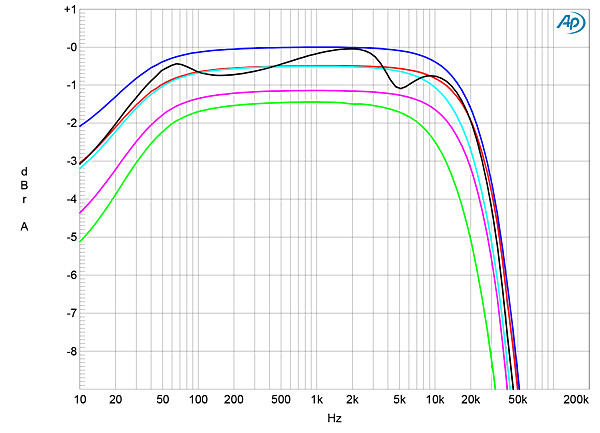
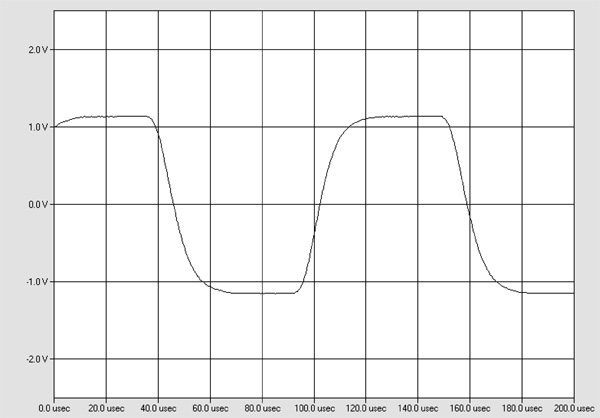
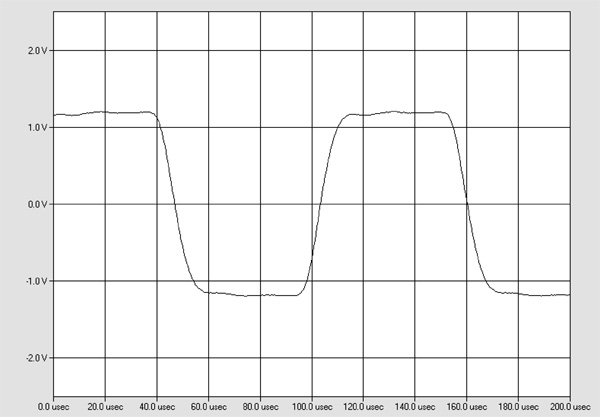
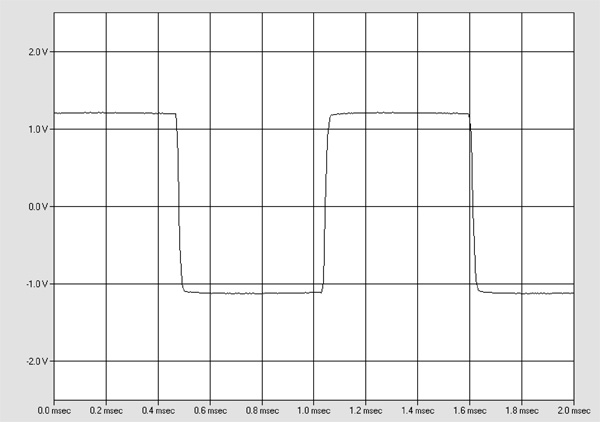
Channel separation was good, at close to 80dB in both directions from 100Hz to 4kHz, decreasing to 64dB at the top of the audioband. In Triode mode, the unweighted, wideband signal/noise ratio, taken with the inputs shorted to ground, was a high 74.2dB (left channel) and 72.4dB (right), ref. 1W into 8 ohms. These S/N ratios improved to 84.8dB with an A-weighting filter in circuit. In Ultralinear mode, the ratios were all 0.5dB lower. Spectral analysis of the low-frequency noise floor (fig.6) revealed a large number of AC-supply–related harmonics at both 60Hz and its odd-order harmonics, due to magnetic interference from the power transformer, as well as at the full-wave–rectified frequency of 120Hz and the other even-number harmonics of 60Hz, due to non-zero impedances to ground somewhere in the circuit. It's fair to note, however, that all of these spuriae lie at or below –80dB (0.01%) and thus won't be audible.
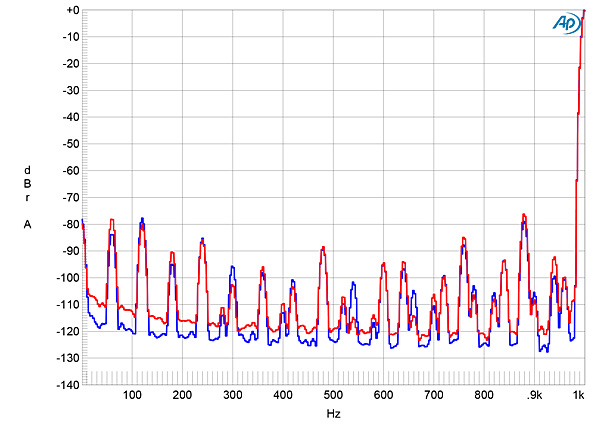
Rogue specifies the Stereo 100 as offering 100Wpc (20dBW into 8 ohms) in Ultralinear mode. Defining clipping as when the THD+noise in the output reaches 1%, my measurements of the Rogue's clipping power were lower than this. Into 8 ohms from the 4 ohm tap in Ultralinear mode (fig.7), the Stereo 100 clipped at 56Wpc (17.5dBW) and 83Wpc into 4 ohms (16.2dBW, fig.8), both with both channels driven. The clipping power from the 8 ohm tap was 80Wpc into 8 ohms (19dBW) and 85Wpc into 4 ohms (16.3dBW). As anticipated, less power was available in Triode mode. The Rogue clipped at 37Wpc with the 4 ohm tap driving 8 ohms (15.7dBW, fig.9), and at 47Wpc into 4 ohms (13.7dBW, fig.10). The maximum output from the 8 ohm tap into 8 ohms in Triode mode was 40Wpc (16dBW). Figs.7–10, which were taken with the left channel, reveal that the Stereo 100 has respectably low distortion at low powers.
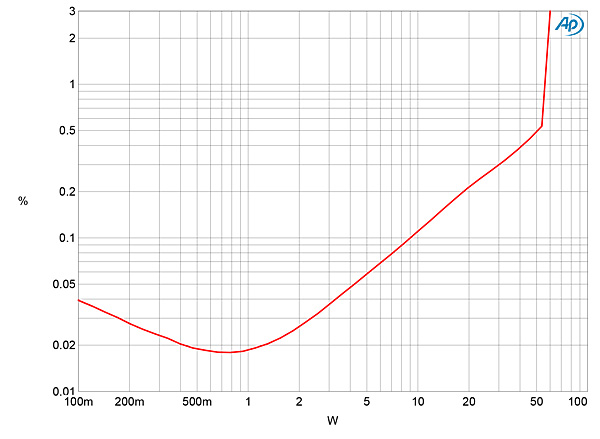
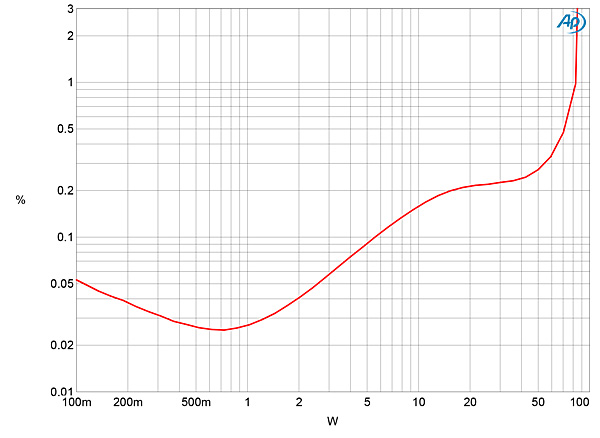
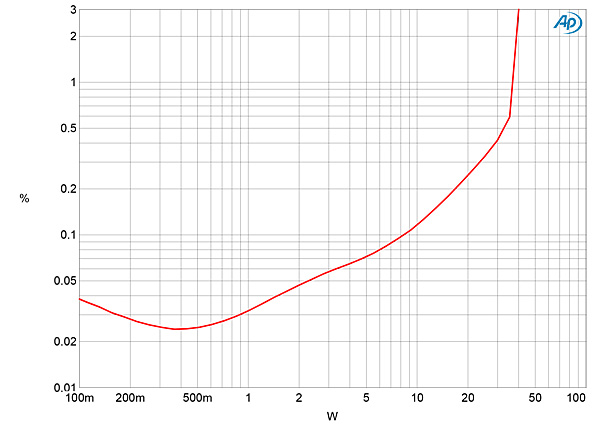
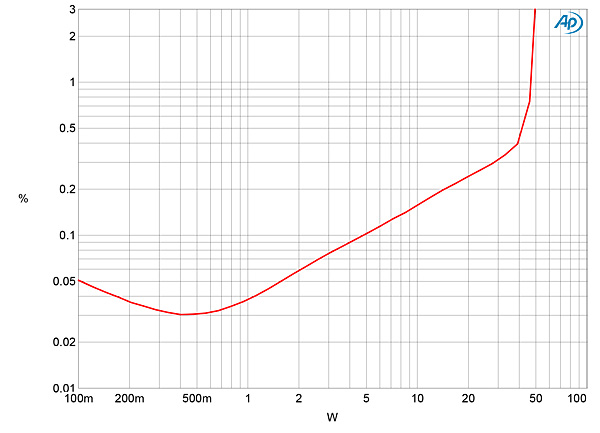
I examined how the Stereo 100's percentage of THD+N varied with frequency at 6.35V (equivalent to 5W into 8 ohms and 10W into 4 ohms) and found that the left channel, which I'd used to measure the clipping powers, was considerably more linear than the right. From the 4 ohm taps in Ultralinear mode (fig.11), the THD+N in the left channel (blue trace) was below 0.1% from 20Hz to 3kHz, but the THD+N in the right channel (red) was three times higher. The two channels matched more closely into 4 ohms (cyan, magenta traces), but this behavior suggests that a tube in the right channel might need replacing. (While performing these tests, I again checked the bias currents to ensure that they were set correctly. They were.) The Stereo 100 behaved similarly in Triode mode (fig.12), but offered higher levels of THD+N at high frequencies than in Ultralinear mode.


Fortunately, the Stereo 100's distortion signature is predominantly the second and third harmonics (fig.13). However, spectral analysis of the amplifier's output while it drove 50Hz at 5Wpc into 8 ohms (4 ohm tap, Ultralinear) confirmed that the right channel (fig.14, red trace) was less linear than the left (blue). While the second and third harmonics were equal in level in both channels, those in the right channel were 12dB higher, with considerably more higher-order harmonics present. Tested with an equal mix of 19 and 20kHz tones with the signal peaking at 5Wpc into 8 ohms (4 ohm tap, Triode), the difference product at 1kHz lay at –46dB (0.2%) in both channels (fig.15), but many more higher-order products were present in the Rogue's right channel (red trace) than the left (blue).
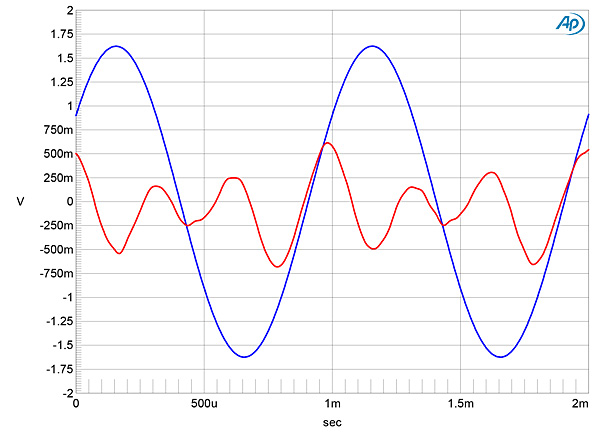
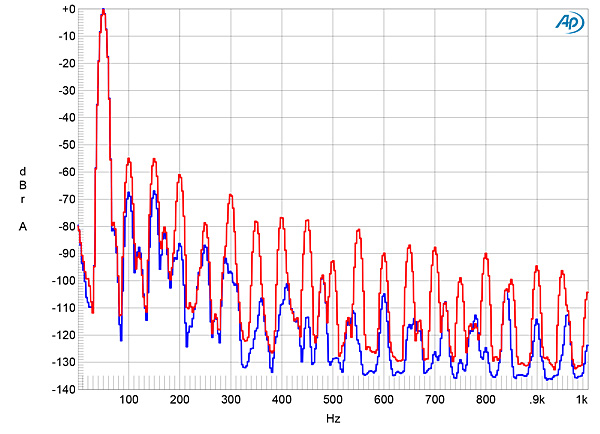
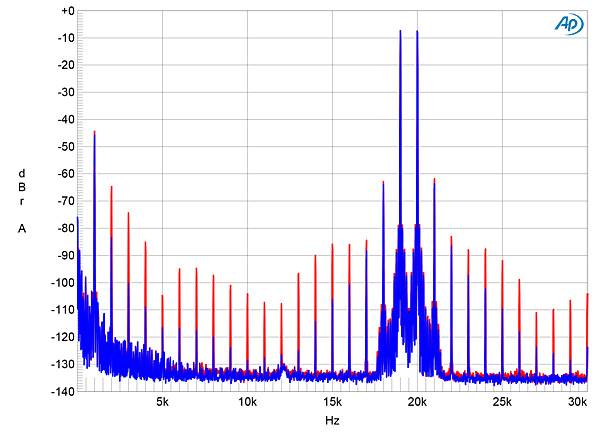
Assuming the right channel's measured performance stems from an out-of-spec output tube, Rogue Audio's Stereo 100 offers respectable measured performance typical of a classic tube design. I don't think the 1dB shortfall in maximum power is a significant failing.—John Atkinson

Another winner from Rogue Audio ($3,500) ......... Congratulations :-) ..........

Pair this amp with Rogue RH-5 pre-amp/headphone amp ($2,500, Stereophile Class-A) ......... We have not only a great amp and pre-amp combo, we can also have a great headphone amp ........ Now, that can be a great "desert island" system :-) ..............

The interior of this amp looks a whole lot better than the $55,000 Constellation audio amp ....... This beauty is more than skin deep :-) .........

...continuously for over 30 years."
Perhaps more amazing, they surely suffered through numerous power outages of varying durations and degrees of abruptness, and simply came back on.

The early Mac amps don't have power switches. They were designed to either be run through the preamps like the C8 or C20, or be fed continual power like refrigerators.

God, this amplifier is so cool! I remember I've found lots of them and had no idea which one to choose. Actually, this one is such a thing! I mean finally I've found exactly what I need! To thanks you, I'd like to tell about one essay writing service. You can read more to learn something about it. It always helps me with all my college troubles, so I hope it's gonna be useful for you too!


"Monica Hunsinger":
Please don't pollute this environment with ads for fraudulent term-paper-writing services.

..to Mark O'Brien and the rest of the folk at Rogue Audio.
This review along with the pic of the ST 100's innards tell the story.
Their Stereo 100 is a HUGE amount of super-high quality amp for the bucks.
They just keep on whacking them out of the park.

Rogue Audio RP5 preamp, Sony HAP-Z1ES digital player feeding Joseph Audio Pulsar speakers. This was ~ 3 years ago.
It is still quite literally the best sounding system these well traveled ears have heard. Absolute magic. Well done Rogue Audio and Stereophile!

Rogue is made by people that answer the dam phone and sleep in Pennsylvania.
They seem to make nice Audio Gear and support their Customers.
They're able to hold on to Dealers for many years.
Looks, to me, like a worthy Company.
Thanks for taking the time on this one.
Tony in Michigan
ps. they even make an Audiophile Class D for Future thinking Solar Power People.

Great article - I have owned this amp for close to a year now. With all of the very expensive amplifier choices out there I am thankful that Rogue Audio considers price as a key factor. This amplifier is so good and competes well with amplifiers costing so much more. What a deal that flies in the face of escalating audiophile prices. The amp is built very well, dead quiet, delicate and powerful with wide soundstage, 3-D imaging and most importantly it conveys music with the body and size of the recording.

Herb should be reviewing 'modern take' JBL L-100 speakers ($4,000) ASAP, to go with this amp :-) ............

to the Harman store to audition the L-100s now......
hr

This is getting weird.
First I complained five years ago to Mikey that the Technics direct drive turntables were being deliberately ignored...and NOW Herb says the same thing about direct drive being (wow-finally!) a GOOD thing.
Then I found BBC monitors and specifically Harbeth Monitor 30s.
So did HERB.
Then I bought a stereo 100 watt Rogue amp (Cronus Magnum II).
So did Herb.
Hey.
Are you guys FOLLOWING me?
Just weird.
By the way Herb your writing is more entertaining than a monkey driving a Ferrari.
Take that anyway you want.
I meant it as a compliment.
Great review.

When JA posted my first Stereophile review, a reader commented, "Oh great, you finally found a worse writer than Cory Greenberg!" I was very flattered. Likewise with your compliment.
Thank you for taking the time to watch me try to reach the clutch peddle.
happy 2019
herb